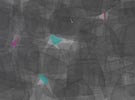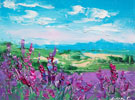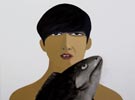Daylight Sparkling-On Wang’s Art
Chinese abstract art is easy to display in abstract ink while difficult to polish in lacquer.
In my childhood, I was warned not to wander outside, or I would be trapped by some kind of magic potion and get lost. I was told that lacquer is so red because bodies are used to angle clam as bait and the left are to nourish the varnish tree. The mystery story maybe useful to teach children but it became a weird obstruction when we appreciate lacquer ware. The house I lived in during my childhood was filled with many red lacquer furnishing. After years of cleansing, all of them became polished and the shine on the surface looks like the setting sun.
After studying history and archeology when grown up, I got to know that lacquer can resist the corrosion from time on the objects. Since the ancient times, the wood of many lacquer ware disappeared after years of transition. However, the lacquer surface adhered to the earth is always shining under the daylight. The art of lacquer always experienced throughout the ages and some places even have special workshop for lacquer. Fujian province is such a place. Without deep research, in childhood I was confused to connect lacquer to such description that Fujian is mysterious, moist and gloomy because it is near to the sea and full of varnish trees because. Until I met Wang Tianliang one day, I saw the lacquer workshop besides the mountain at first time. Wang Tianliang leads a formal arts and crafts college as president and develops lacquer so miscellaneous and luxuriant. In fact, lacquer is not colored, only if pigments are mixed in lacquer and become solidified it will spread glorious shine and flavor after polishing and cleaning. I always produce works with red, but I never such red as lacquer. When I saw the red in Wang Tianliang’s artworks in his dim workshop, I found it is the red I am expecting. I requested a little cinnabar when I parted from Wang Tianliang and made an appointment to meet in Beijing again. It seems that we both reached an agreement to permeate Chinese abstract art, especially modern calligraphy as representative of abstract art, to the producing of profound and gloomy lacquer. Several years later, I saw Wang Tianliang’s artworks and found he almost completely made it come true to connect them perfectly. Appreciating the shine of lacquer after the solidifying of the vivid painting and polishing, I believe that Chinese abstract art really completed a blossom and fruitage out of the ordinary.
The technology of producing the protection of color with kinds of resins mixed with some other materials is known in many countries all over the world. Such as the oil for oil-painting is also the connection of resin and other paint materials, so the early Netherlands oil-painting is also some kind of lacquer to some extent. When Western oil-painting developed to Venetian school, palette knife work gradually became far away from the polishing effect of the picture plane. Meanwhile, the technique of drawing also became unstrained. However, the most fundamental change was from the generation such as Picasso and Kandinsky. The image they painted with heart and true feeling of their own broke away from the human’s dependence on visual images for millions upon millions years. They accomplished the freedom of pigment after abstract art and made the paintings become cheerful but a little frivolous. It seems there is a unidirectional way on the oil-painting’s development. When the earliest ancestor of oil-painting gave up the reflected combination of conditioner, coagulating agent and pigment, we could not find the aesthetic perception by the connection of time and artificial burnish of the material itself from abstract art. After the affection of abstract art on China, a great amount of abstract ink-painting, rice paper, hair pencil, splash-ink, color-rubbing and so on became a vogue. However, we really feel unbearable when we look back on the achievement of abstract ink-painting from 1979. After all no matter how huge and animated the artworks, they could not get rid off some “frivolity”. Wang Tianliang is a personage with good achievement in early abstract ink-painting. He grew up along with China modern art. He benefitted from the selfhood liberating of abstract art and also strained by the frivolity of itself. This problem not only appears in abstract ink-painting on rice paper, but also in the comparison between European abstract painting and Netherlands oil-painting. Therefore, we expect there is such an artist that can bring abstraction back to oil-painting and even before the source of oil-painting. The expectation is based on lacquer painting.
Such is the pleasure we acquired from the exhibition. Wang Tianliang’s art, no matter on plane or three-dimensional artworks, either is a plate of paradoxical figure or historical and modern huge structure. The spirituality and change appearing from calligraphy following abstract art are seized into profound lacquer. In that case, the modern spirit is smeared by magic potion of history and the paintings look much more vivid. The ware is from the seacoast while the body is as human bait to catch gold, silver and amber. All of them nourish varnish tree and become lacquer so the paintings are so shiny and the wares are so grandeur.
I do not know how the later generations regard Wang Tianliang. However, I believe they will treasure theses artworks, because Chinese abstract art finally could resist the corrosion of time in archeology and history.
Zhu Qingsheng (Professor of Beijing University)
2011.7.12




